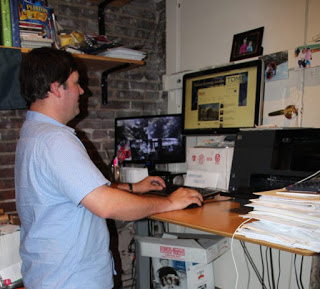Sitting down? It could be killing you; how about a standup desk?

 |
| Burger Boy owner Dan Borsch of Louisville at his standup desk (Insider Louisville photo courtesy of Dan Borsch) |
Louisville restaurateur Dan Borsch made the switch to a standup desk after suffering a back injury three years ago.”It took about two weeks to get used to the standing aspect of it,” Borsch told Shaw. “After that, I don’t notice it all — and I love it.”
Borsch said he is pain-free, and attributes his back relief to the $1,000 desk, not his exercises. “I do believe that, because of the standing desk, my back has been better than it would have been otherwise — without a doubt.”
Prolonged or leisurely sitting contributes to metabolic syndrome, which the Mayo Clinic defines as “a cluster of conditions — increased blood pressure, high blood sugar, excess body fat around the waist, and abnormal cholesterol or triglyceride levels — that occur together, increasing your risk of heart disease, stroke and diabetes.” The Mayo Clinic describes in more detail what happens:
“Red blood cells in your legs begin to clump together, thickening inside your vessels and slowing circulation. If, later, you notice a further drop in energy, it’s because your body’s insulin
production is down. The sugars . . . linger in your bloodstream, rather than being ushered into your muscles for energy. Soon a key element responsible for vacuuming fat out of the blood deactivates. Small amounts of fat begin to accumulate in your blood; your body will store it in an easy-to-access central location — your gut.”
Mayo adds, “You may also have hunger cravings, even though you haven’t moved. That’s because your appetite-regulating hormones leptin and ghrelin have gone off-kilter. Meanwhile . . . deep within your leg muscles, a gene critical for suppressing clotting and inflammation switches off. By the end of the day, even with a lunch break and trips to the water cooler, your good cholesterol and insulin sensitivity may have fallen 20 to 40 percent.”
Shaw writes, “Sitting disease may be even more concerning to women than men.” A study by Alpa Patel, an epidemiologist with the American Cancer Society, found that “men who spent six hours or more per day of their leisure time sitting had an overall death rate that was about 20 percent higher than men who sat for three hours or less. The death rate for women who sat more than six hours a day was about 40 percent higher.”
Patel writes that leisure-time sitting “has been associated with greater mortality, cardiovascular disease, type II diabetes mellitus, obesity, and some cancers . . . markers of chronic disease risk such as weight gain, high cholesterol, high fasting insulin levels, and other biomarkers.” She estimates that, on average, people who sit too much “shave years off their lives.”
Convinced that standing during his long workdays will improve his health, Borsch tells Shaw that it’s likely he’ll never sit at his desk again. “Once you make that two-week transition or maybe three weeks — or however long it takes somebody to make that initial adjustment — there’s no looking back.”
If buying a standup desk isn’t on your to-do-list, Bonnie Berkowitz and Patterson Clark from The Washington Post recommend “sitting on something wobbly, stretching the hip flexors, walking during breaks, alternating between sitting and stranding, and trying yoga poses.”